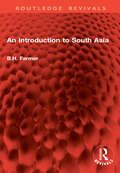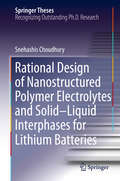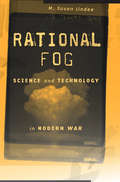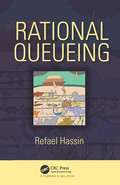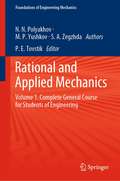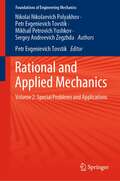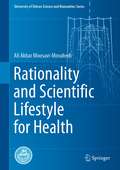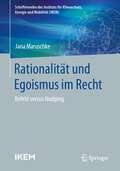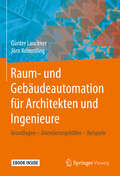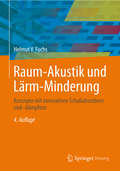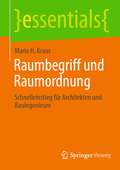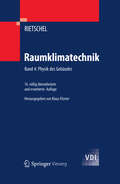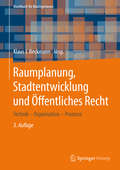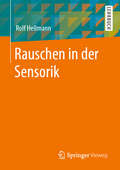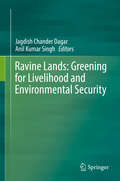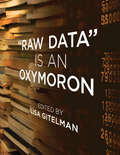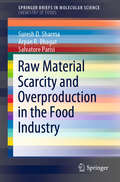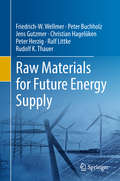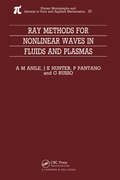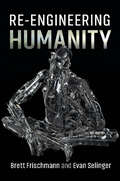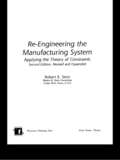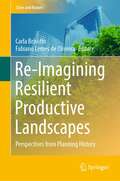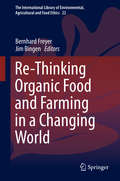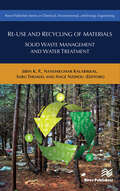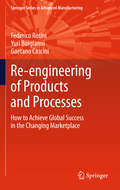- Table View
- List View
Rational Approaches to Structure, Activity, and Ecotoxicology of Agrochemicals
by Wilfried Draber Toshio FujitaThis book presents discussions of the most important aspects in the development of agrochemicals. The book covers such broad areas as structure activity and ecotoxicological analyses in comprehensive reviews for general methods and chronicles for individual examples. Topics in structure-activity relationships include how to combine submolecular structures of pharmacological interests and modify them according to chemorational models with computer-aided procedures such as the traditional Hansch-type QSAR, the sequential, simplex optimization, and molecular modeling. Topics in the ecotoxicology of organo phosphorus compounds are discussed in terms of the quantitative structure-toxicity relationship (QSTR). Chronicles of molecular orbital methodology in predicting environmental fates of agrochemicals are also provided. This volume will be invaluable for researchers in the agrochemical and pharmaceutical industries.
Rational Design of Nanostructured Polymer Electrolytes and Solid–Liquid Interphases for Lithium Batteries (Springer Theses)
by Snehashis ChoudhuryThis thesis makes significant advances in the design of electrolytes and interfaces in electrochemical cells that utilize reactive metals as anodes. Such cells are of contemporary interest because they offer substantially higher charge storage capacity than state-of-the-art lithium-ion battery technology. Batteries based on metallic anodes are currently considered impractical and unsafe because recharge of the anode causes physical and chemical instabilities that produce dendritic deposition of the metal leading to catastrophic failure via thermal runaway. This thesis utilizes a combination of chemical synthesis, physical & electrochemical analysis, and materials theory to investigate structure, ion transport properties, and electrochemical behaviors of hybrid electrolytes and interfacial phases designed to prevent such instabilities. In particular, it demonstrates that relatively low-modulus electrolytes composed of cross-linked networks of polymer-grafted nanoparticles stabilize electrodeposition of reactive metals by multiple processes, including screening electrode electrolyte interactions at electrochemical interfaces and by regulating ion transport in tortuous nanopores. This discovery is significant because it overturns a longstanding perception in the field of nanoparticle-polymer hybrid electrolytes that only solid electrolytes with mechanical modulus higher than that of the metal electrode are able to stabilize electrodeposition of reactive metals.
Rational Fog: Science And Technology In Modern War
by M. Susan LindeeA thought-provoking examination of the intersections of knowledge and violence, and the quandaries and costs of modern, technoscientific warfare.Science and violence converge in modern warfare. While the finest minds of the twentieth century have improved human life, they have also produced human injury. They engineered radar, developed electronic computers, and helped mass produce penicillin all in the context of military mobilization. Scientists also developed chemical weapons, atomic bombs, and psychological warfare strategies.Rational Fog explores the quandary of scientific and technological productivity in an era of perpetual war. Science is, at its foundation, an international endeavor oriented toward advancing human welfare. At the same time, it has been nationalistic and militaristic in times of crisis and conflict. As our weapons have become more powerful, scientists have struggled to reconcile these tensions, engaging in heated debates over the problems inherent in exploiting science for military purposes. M. Susan Lindee examines this interplay between science and state violence and takes stock of researchers’ efforts to respond. Many scientists who wanted to distance their work from killing have found it difficult and have succumbed to the exigencies of war. Indeed, Lindee notes that scientists who otherwise oppose violence have sometimes been swept up in the spirit of militarism when war breaks out.From the first uses of the gun to the mass production of DDT and the twenty-first-century battlefield of the mind, the science of war has achieved remarkable things at great human cost. Rational Fog reminds us that, for scientists and for us all, moral costs sometimes mount alongside technological and scientific advances.
Rational Queueing (Chapman & Hall/CRC Series in Operations Research)
by Refael HassinUnderstand the Strategic Behavior in Queueing SystemsRational Queueing provides one of the first unified accounts of the dynamic aspects involved in the strategic behavior in queues. It explores the performance of queueing systems where multiple agents, such as customers, servers, and central managers, all act but often in a noncooperative manner.T
Rational and Applied Mechanics: Volume 1. Complete General Course for Students of Engineering (Foundations of Engineering Mechanics)
by Nikolai Nikolaevich Polyakhov Mikhail Petrovich Yushkov Sergey Andreevich ZegzhdaAvailable for the first time in English, this two-volume course on theoretical and applied mechanics has been honed over decades by leading scientists and teachers, and is a primary teaching resource for engineering and maths students at St. Petersburg University.The course addresses classical branches of theoretical mechanics (Vol. 1), along with a wide range of advanced topics, special problems and applications (Vol. 2). This first volume of the textbook contains the parts “Kinematics” and “Dynamics”. The part “Kinematics” presents in detail the theory of curvilinear coordinates which is actively used in the part “Dynamics”, in particular, in the theory of constrained motion and variational principles in mechanics. For describing the motion of a system of particles, the notion of a Hertz representative point is used, and the notion of a tangent space is applied to investigate the motion of arbitrary mechanical systems. In the final chapters Hamilton-Jacobi theory is applied for the integration of equations of motion, and the elements of special relativity theory are presented.This textbook is aimed at students in mathematics and mechanics and at post-graduates and researchers in analytical mechanics.
Rational and Applied Mechanics: Volume 2. Special Problems and Applications (Foundations of Engineering Mechanics)
by Nikolai Nikolaevich Polyakhov Mikhail Petrovich Yushkov Sergey Andreevich Zegzhda Petr Evgenievich TovstikAvailable for the first time in English, this two-volume course on theoretical and applied mechanics has been honed over decades by leading scientists and teachers, and is a primary teaching resource for engineering and maths students at St. Petersburg University.The course addresses classical branches of theoretical mechanics (Vol. 1), along with a wide range of advanced topics, special problems and applications (Vol. 2). Among the special applications addressed in this second volume are: stability of motion, nonlinear oscillations, dynamics and statics of the Stewart platform, mechanics under random forces, elements of control theory, relations between nonholonomic mechanics and the control theory, vibration and autobalancing of rotor systems, physical theory of impact, statics and dynamics of a thin rod.This textbook is aimed at students in mathematics and mechanics and at post-graduates and researchers in analytical mechanics.
Rationality and Scientific Lifestyle for Health (University of Tehran Science and Humanities Series)
by Ali Akbar Moosavi-MovahediThis book argues that, to be healthy, human beings should love nature and stay in balance with it as much as possible. In other words: do not unbalance nature so that your own balance is not disturbed. The best and healthiest way for human beings to live is to find balance in life and nature. In this regard, the book discusses useful, nutritious, functional foods, nutraceuticals and antioxidants, and how natural molecules, which are provided by nature, can be the best medicine for human beings. At a molecular level, stress is defined by the presence of unbalanced free radicals in the body. Most diseases – especially type 2 diabetes, which accounts for the majority of diabetics – can be traced back to this problem. Our scientific evidence indicates that type 2 diabetes isn’t just a disease resulting from sugar, but also from stress. The book seeks to promote a healthier lifestyle by considering the psychoemotional dimension of wellness. And finally, it contends that good sleep is at the root of health and happiness for humanity, and that unbalanced free radicals are expelled from the body during restful sleep.The authors hope that this book will be a helpful guide and source of peace for readers, especially given their need for inner calm during the COVID-19 pandemic, and that the suggestions provided will show them the way to a better life.
Rationalität und Egoismus im Recht: Befehl versus Nudging (Schriftenreihe des Instituts für Klimaschutz, Energie und Mobilität)
by Jana MaruschkeDieses Buch fragt danach, wie Recht und Rechtsprechung, Staats- und Rechtstheorie sowie moderne Verhaltensökonomie die Rationalität und den Egoismus des Menschen begreifen und wie dies die Wahl staatlicher Steuerungsinstrumente beeinflusst. Das scheinbar neuartige Instrument Nudging wird mit Blick auf Umweltschutzinstrumente, die Regulierung des Tabakrauchens und der Organspende in den öffentlich-rechtlichen Handlungsformenkatalog eingeordnet, wobei verfassungsrechtliche Grenzen diskutiert werden. Zielgruppe sind die an der "Metaebene" des Rechts und der Verhaltenssteuerung interessierten Leserinnen und Leser.
Raum- und Gebäudeautomation für Architekten und Ingenieure: Grundlagen – Orientierungshilfen – Beispiele
by Jörn Krimmling Gunter LaucknerDieses Fachbuch vermittelt anhand von Praxis-Beispielen verschiedener Gebäudearten die wichtigsten Aspekte der Gebäudeautomation. Dem Architekten und Planer als Hauptzielgruppe werden alle notwendigen Grundlagen und Zusammenhänge vermittelt, die er für das Fachgespräch mit dem Fachingenieur oder für die Beratung seines Bauherren zu dieser Thematik benötigt.
Raum-Akustik und Lärm-Minderung: Konzepte mit innovativen Schallabsorbern und -dämpfern (VDI-Buch)
by Helmut V. FuchsDie 4. Auflage dieses inzwischen als Standardwerk anerkannten Fachbuchs greift wieder aktuelle Probleme bei der Gestaltung von Raum-Akustik, Freifeld-Pr#65533;fst#65533;nden und Kanal-Auskleidungen auf. Zu deren nachhaltiger L#65533;sung werden Materialien und Bauteile sowie Auslegungskonzepte nach neuestem Stand des Wissens allgemein verst#65533;ndlich dargestellt. Aufbauend auf den Grundlagen wird das Konzept vertieft. Mehr als 100 Fallbeispiele zeigen, welche konstruktiven und baulichen Ma#65533;nahmen schnell und kosteng#65533;nstig zum Ziel f#65533;hren k#65533;nnen. Akustiker in der Praxis und Forschung sowie entwerfende und planende Architekten, Bauingenieure und Haustechniker finden neben den Grundlagen und Konzepten besonders auf f#65533;r bisher vernachl#65533;ssigten Bereich der tiefen Frequenzen wichtige Hinweise. In Darstellung und L#65533;sung akuter schalltechnischer Probleme stellt der Autor auch neue Erkenntnisse und Konzepte zur Verf#65533;gung, bei denen stets das praktisch N#65533;tzliche im Vordergrund steht. F#65533;r die eingef#65533;hrten Normen werden Probleml#65533;sungen ebenso behandelt wie die Grenzen der Anwendung, wo weiterf#65533;hrende L#65533;sungen gesucht werden. F#65533;r L#65533;rmprobleme in Arbeits- und Freizeit-R#65533;umen liefert das Buch eine F#65533;lle konstruktiver Anregungen.
Raumbegriff und Raumordnung: Schnelleinstieg für Architekten und Bauingenieure (essentials)
by Mario H. KrausRaum ist ein mehrdeutiger und gelegentlich umstrittener Begriff. Raumordnung beruht auf einem empfindlichen und veränderlichen gesellschaftlichen Gleichgewicht, das sich in den Rechtsgrundlagen und der alltäglichen Umsetzung widerspiegelt. In diesem essential werden Ansätze aus der Phänomenologie zur Einordnung der verschiedenen Raumbegriffe genutzt.
Raumklimatechnik
by Klaus FitznerDas 4-bändige Werk ist die Fortführung des "Leitfadens zum Berechnen und Entwerfen von Lüftungs- und Heizungsanlagen". Für die Neuauflage wurde es völlig neu strukturiert und stärker an einer integrierten Betrachtung des Gebäudes und seiner klimatechnischen Anlagen ausgerichtet. In Band 4 wird das Zusammenwirken von Raumlufttechnik, Energietechnik und Gebäude behandelt. Die Konsequenzen der Energiesparverordnungen und des Erneuerbare-Energien-Wärmegesetzes werden erläutert und der Stand der Technik zur Nutzung regenerativer Energien beschrieben.
Raumplanung, Stadtentwicklung und Öffentliches Recht: Technik – Organisation – Prozesse (Handbuch für Bauingenieure)
by Klaus J. BeckmannDas in 3. Auflage erscheinende Standardwerk des Bauingenieurwesens bietet Grundwissen kompakt, umfassend und aktuell. Das Handbuch wurde den aktuellen Normen und Richtlinien sowie veränderten Zielen und Wertsetzungen angepasst und versteht sich als Lehrbuch für Studierende und Nachschlagewerk für Praktiker.Neben den klassischen Fächern des Konstruktiven Ingenieurbaus, des Grundbaus, der Bauwirtschaft und des Wasser- sowie Verkehrswegebaus zählt dazu notwendigerweise das Methodenwissen über die planerischen Grundlagen und die rechtliche Sicherung der Raumplanung, Stadt- und Infrastrukturentwicklung. Die Methoden und Prozesse der Vorbereitung und Sicherung von baulichen Anlagen und Infrastrukturen sind zum Teil im Städtebaurecht, im öffentlichen Baurecht wie auch im Umweltrecht kodifiziert.
Rauschen in der Sensorik
by Rolf HeilmannDas Buch bietet für im Labor tätige Ingenieure und Physiker eine kurze Einführung in das Thema Rauschen, welches in der Messtechnik sehr relevant ist. Basierend auf dem theoretischen Hintergrund kann die digitale Signalverarbeitung für alle Anwender und Lernenden neue Möglichkeiten bieten, Rauschen zu quantifizieren und zu reduzieren. Auch unter diesem Gesichtspunkt ist eine neue, kompakte Darstellung des Gebietes überfällig.
Ravine Lands: Greening for Livelihood and Environmental Security
by Jagdish Chander Dagar Anil Kumar SinghThis book, the only one of its kind on ravine lands, reflects the significant advances made over the past two decades in our understanding of gully erosion, its controlling factors, and various aspects of gully erosion. It also addresses central research gaps and unanswered questions, which include historical studies on gully erosion to better understand the different stages of their formation; appropriate measuring techniques for monitoring or assessing the geological and hydrological parameters and processes involved in gully development; interaction of hydrological and other soil degradation processes; ecology and biodiversity of fragile ravines; impact of climate and environmental changes on soil erosion processes; development of effective and reliable gully erosion models; effective gully prevention and control measures; watershed-based management options; and ravine rehabilitation policies. The present book is a highly timely publication and deals with various aspects of ravine ecology and rehabilitation of degraded lands, particularly with the aid of biological approaches. As such, it offers a valuable guide for all scientists working in the fields of soil conservation / rehabilitation and agroforestry, students, environmentalists, educationists, and policymakers. More importantly, it focuses on the rehabilitation of one of the world’s most degraded and fragile ecosystems, ensuring the livelihoods of resource-poor farmers and landless families living in harsh ecologies that are more vulnerable to climate change.
Raw Data Is an Oxymoron (Infrastructures)
by Lisa GitelmanEpisodes in the history of data, from early modern math problems to today's inescapable “dataveillance,” that demonstrate the dependence of data on culture. We live in the era of Big Data, with storage and transmission capacity measured not just in terabytes but in petabytes (where peta- denotes a quadrillion, or a thousand trillion). Data collection is constant and even insidious, with every click and every “like” stored somewhere for something. This book reminds us that data is anything but “raw,” that we shouldn't think of data as a natural resource but as a cultural one that needs to be generated, protected, and interpreted. The book's essays describe eight episodes in the history of data from the predigital to the digital. Together they address such issues as the ways that different kinds of data and different domains of inquiry are mutually defining; how data are variously “cooked” in the processes of their collection and use; and conflicts over what can—or can't—be “reduced” to data. Contributors discuss the intellectual history of data as a concept; describe early financial modeling and some unusual sources for astronomical data; discover the prehistory of the database in newspaper clippings and index cards; and consider contemporary “dataveillance” of our online habits as well as the complexity of scientific data curation. Essay Authors Geoffrey C. Bowker, Kevin R. Brine, Ellen Gruber Garvey, Lisa Gitelman, Steven J. Jackson, Virginia Jackson, Markus Krajewski, Mary Poovey, Rita Raley, David Ribes, Daniel Rosenberg, Matthew Stanley, Travis D. Williams
Raw Material Scarcity and Overproduction in the Food Industry (SpringerBriefs in Molecular Science)
by Salvatore Parisi Suresh D. Sharma Arpan R. BhagatThis book describes the consequences of an increased demand for food for human consumption for the global food industry. In four concise chapters, the authors explore the trend for the overproduction of food, the concomitant diminution of raw materials and the increase in environmental concerns. Chapter one describes the variations in biochemical properties of fishmeal depending on the season and geographical location. Chapter two discusses how the expansion of cropland and pastures to meet the rising demand for food is damaging the environment, while chapter three examines the impact of bee viruses on food crops and production. Lastly, the fourth chapter addresses the issue of food adulteration and provides specific examples of fraud in the American dairy industry. This book is of interest to researchers working in the area of food production in academia and industry, as well as certification and scientific bodies involved in food inspection.
Raw Materials for Future Energy Supply
by Peter Buchholz Friedrich-W. Wellmer Jens Gutzmer Christian Hagelüken Peter Herzig Ralf Littke Rudolf K. ThauerThis is the first book that analyses the future raw materials supply from the demand side of a society that chiefly relies on renewable energies, which is of great significance for us all. It addresses primary and secondary resources and substitution, not only from technical but also socioeconomic and ethical points of view.The “Energiewende” (Energy Transition) will change our consumption of natural resources significantly. When in future our energy requirements will be covered mostly by wind, solar power and biomass, we will need less coal, oil and natural gas. However, the consumption of minerals, especially metallic resources, will increase to build wind generators, solar panels or energy storage facilities. Besides e.g. copper, nickel or cobalt, rare earth elements and other high-tech elements will be increasingly used. With regard to primary metals, Germany is 100 % import dependent; only secondary material is produced within Germany. Though sufficient geological primary resources exist worldwide, their availability on the market is crucial. The future supply of the market is dependent on the development of prices, the transparency of the market and the question of social and ethical standards in the raw materials industry, as well as the social license to operate, which especially applies to mining. The book offers a valuable resource for everyone interested in the future raw material supply of our way of life, which will involve more and more renewable energies.
Ray Methods for Nonlinear Waves in Fluids and Plasmas (Monographs And Surveys In Pure And Applied Mathematics Ser.)
by Marcelo Anile P Pantano G Russo J HunterPresents in a systematic and unified manner the ray method, in its various forms, for studying nonlinear wave propagation in situations of physical interest, essentially fluid dynamics and plasma physics.
Re-Engineering Humanity
by Evan Selinger Brett FrischmannEvery day, new warnings emerge about artificial intelligence rebelling against us. All the while, a more immediate dilemma flies under the radar. Have forces been unleashed that are thrusting humanity down an ill-advised path, one that's increasingly making us behave like simple machines? <P><P>In this wide-reaching, interdisciplinary book, Brett Frischmann and Evan Selinger examine what's happening to our lives as society embraces big data, predictive analytics, and smart environments. They explain how the goal of designing programmable worlds goes hand in hand with engineering predictable and programmable people. <P>Detailing new frameworks, provocative case studies, and mind-blowing thought experiments, Frischmann and Selinger reveal hidden connections between fitness trackers, electronic contracts, social media platforms, robotic companions, fake news, autonomous cars, and more. <P>This powerful analysis should be read by anyone interested in understanding exactly how technology threatens the future of our society, and what we can do now to build something better.<P> Offers an academically rigorous and interdisciplinary analysis.<P> Written in accessible prose with resonant examples.<P> Includes mind-blowing thought experiments.
Re-Engineering the Manufacturing System: Applying the Theory of Constraints, Second Edition
by Robert E. SteinAn information systems trailblazer in the domains of decision support and factory and supply chain synchronization, the second edition of Re-Engineering the Manufacturing System stays true to its title, once again bestowing uniquely straightforward instructions for designing, installing, and operating manufacturing information systems. This updated and expanded source takes care to clarify the often blurred concepts of synchronization and optimization and offers implementation advice from four discrete angles to yield better bottom-line results. It shows how to exploit an information system, rolling ERP system implementation into the TOC framework to promote profit materialization.
Re-Imagining Resilient Productive Landscapes: Perspectives from Planning History (Cities and Nature)
by Fabiano Lemes de Oliveira Carla BrisottoThis book explores how lessons from past urban planning experiences can inform current debates on urban agriculture. Productive landscapes today have been posited as instruments for the positive transformation related to territorial fragility and abandonment, promoting social cohesion, food security and wider environmental and economic benefits. The book will re-map the way in which seeming landscape limitations and challenges can be turned into potential, innovation and a new lease of urban-rural life. It does so by drawing on significant past urban agricultural experiences in planning as vectors for new critical reflections relevant to re-igniting ideas for future envisioning of urban scenarios in which productive landscapes play fundamental transformative roles. The focus is on planning ideas and the roles of key individual planners, all of which have designed agricultural strategies for the city at some point in their careers. It intends to help us today reimagine urban-rural relationships, and the transformation of under or mis-used urban open spaces, peri-urban areas, fringe conditions and in-between spaces.
Re-Thinking Organic Food and Farming in a Changing World
by Bernhard Freyer Jim BingenThis book is based on the assumption that "organic has lost its way". Paradoxically, it comes at a time when we witness the continuing of growth in organic food production and markets around the world. Yet, the book claims that organic has lost sight of its first or fundamental philosophical principles and ontological assumptions. The collection offers empirically grounded discussions that address the principles and fundamental assumptions of organic farming and marketing practices. The book draws attention to the core principles of organic and offers different clearly articulated and well-defined conceptual frameworks that offer new insights into organic practices. Divided into five parts, the book presents new perspectives on enduring issues, examines standards and certification, gives insights into much-discussed and additional market and consumer issues, and reviews the interplay of organic and conventional farming. The book concludes with a framework for rethinking ethics in the organic movement and reflections on the positioning of organic ethics.
Re-Use and Recycling of Materials: Solid Waste Management and Water Treatment (River Publishers Series In Chemical, Environmental, And Energy Engineering Ser.)
by Sabu Thomas Nandakumar Kalarikkal Ange Nzihou Jibin K. P.In recent years, a considerable amount of effort has been devoted, both in industry and academia, towards the recycling and reuse of materials. Most nations are now trying to reduce the amount of waste materials, through the proper recycling of materials.Re-Use and Recycling of Materials will help readers to understand the current status in the field of waste management, as well as what research is taking place to deal with such issues.Technical topics discussed in the book include: Municipal solid waste management Recycling of WEEE Waste to industrially important product like lignin and cellulose Recycling of agriculture waste Polymer and plastic recycling
Re-engineering of Products and Processes
by Yuri Borgianni Federico Rotini Gaetano CasciniWhilst previous methods for business process reengineering have focused on time and cost reduction policies to preserve competitive services and products, Re-engineering of Products and Processes: How to Achieve Global Success in the Changing Marketplace presents a new approach which aims to include aspects that impact the customer perceived value. This method supports business reengineering initiatives by identifying process bottlenecks as well as new products and services viable to overcome market competition. This original approach is described step-by-step, explaining the theory through examples of performable tasks and the selection of relevant tools according to the nature of the problem. Supported by illustrations, tables and diagrams, Re-engineering of Products and Processes: How to Achieve Global Success in the Changing Marketplace clearly explains a method which is then applied to several case studies across different industrial sectors. Re-engineering of Products and Processes: How to Achieve Global Success in the Changing Marketplace provides a scientific reference for researchers and PhD students working in several fields of the Industrial Engineering: mechanical, electric, electronic sectors and, more in general, all the industrial areas where there are needs to design innovative products. The step-by-step description on how to employ the proposed method and its application to practical examples, make the book a key resource for industry consultants and managers who look to increase the value of their products and services for new and existing customers.
